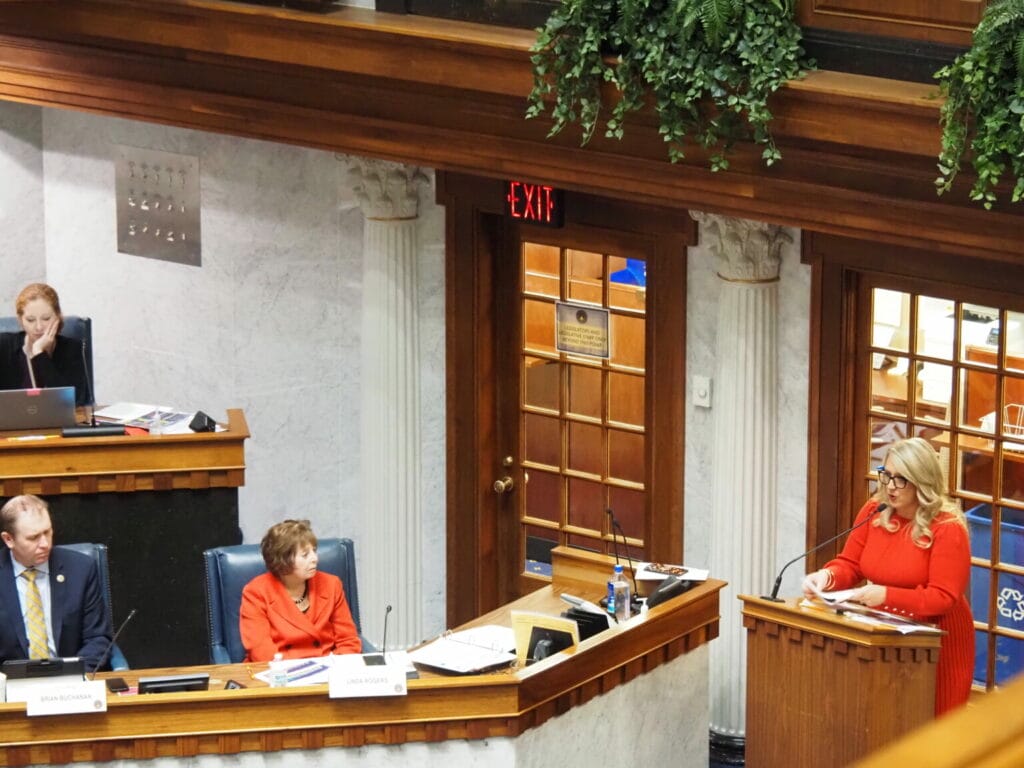Some schools will adopt new testing through a pilot program this fall before the changes take effect statewide in 2025.
An option for schools to divvy up portions of Indiana’s ILEARN exams was approved by state lawmakers at the end of the 2024 legislative session and will change how thousands of Hoosier students are tested.
The provision was included in House Enrolled Act 1243, an omnibus education bill filled with action items supported by the Indiana Department of Education.
The assessment plan includes what state education officials call “flexible checkpoints” for schools to administer ILEARN preparation tests in language arts and math before the typical end-of-year summative tests. A dozen other states already have similar models.
Based on a plan approved by the Indiana’s State Board of Education last summer, the “checkpoints” will consist of 20 to 25 questions and hone in on four to six state standards. The exams are designed to be administered to students about every three months, but local schools and districts can speed up testing if they wish.
“It’s a good first step,” said bill author Rep. Bob Behning, R-Indianapolis. “We are actually going to reduce the amount of time that we’re going to be spending on the summative test at the end of the year.”
Rather, schools will have “windows of time” to use the checkpoint assessments to monitor student success.
“It really, I think, moves us closer to having the ability to have a mastery-based system,” Behning continued.
Schools pilot through-year assessments
Last summer, the state board of education approved new “streamlined” K-12 education standards to make it easier for teachers to craft individualized lesson plans — setting the stage for updates to standardized testing.
Unlike the end-of-year ILEARN tests, checkpoint exams are not meant to be “high stakes,” and results are not reported to the state, said Indiana Secretary of Education Katie Jenner.

Instead, the tests are designed to be diagnostic and help teachers and parents see where students are throughout the year. Jenner said this will help educators implement remediations and interventions — like additional tutoring for students who need it — ahead of the summative exam at the end of the academic year.
Because each checkpoint covers various Indiana academic standards at different points in the school year, the end-of-year test will be reduced in length, according to guidance issued by IDOE.
IDOE will pilot the checkpoint model in the 2024-25 school year. More than 1,200 schools have opted-in to offer those assessments.
The checkpoint tests will be administered digitally without a time limit. IDOE’s plan is for schools in the pilot to give the first checkpoint exam between Sept. 16 and Nov. 15, the second between Nov. 18 and Feb. 7, and the third between Feb. 10 and April 11. Second-chance opportunities will be available for each checkpoint until the summative window begins on April 14, 2025.
“This is wildly popular amongst our educators, amongst our parents, because what this does is it gives not just end-of-year, one-point-in-time data, but it allows three checkpoints throughout the year on that student that are not punitive, that are totally about, ‘Has the child mastered it or not?’ Jenner said earlier this year.
The overall system will take effect during the 2025-26 school year.
Students who move into a new district mid-year will not be required to make up any missed checkpoint assessment. But schools will be allowed to use the “second chance” opportunity to see if students have mastered the previous content or if they need additional learning support, according to the state education department.
Under House Enrolled Act 1243, high school students will additionally be given the option to include their latest statewide assessment scores on their transcripts.
Although the bill passed with few naysayers, Sen. Jean Leising, R-Oldenburg, said she’s heard complaints from “lots of parents” in her district about kids already “having to undergo too much testing.”
“I don’t know if I’m ready to vote for another change, because I think that we have tested the heck out of kids,” she said shortly before voting against the measure on the last day of the legislative session. “And we have not improved education — and that’s the sad part about it. I don’t know why they’re separating it.”
“I don’t know how it’s all going to work, but I’m starting to feel sorry for the kids and teachers and the parents,” she continued. “Because all of this testing — we’ve reached a point of it just being over the top.”
Slow student progress on ILEARN
The latest ILEARN data from 2023 showed an increasing number of Hoosier students in grades 3-8 passed state standardized tests — a sign of continued learning loss recovery following the COVID-19 pandemic.
But the scores still trailed behind 2019 results, and students who struggled before the pandemic were not making academic rebounds as fast as their peers.
Nearly 41% of Indiana students who were tested in Spring 2023 were at or above proficiency standards in English and language arts. Roughly the same percentage of students were at or above proficiency standards in math.
Only 30.6% of Hoosier students passed both the math and English sections of ILEARN, however. In 2019, pre-pandemic pass rates indicated that 37.1% of Hoosier kids in grades 3-8 were proficient in both the English and math portions of the exam.
IDOE officials said 99% of all Indiana students in grades 3-8 completed ILEARN exams last year. That’s equal to more than 491,000 students tested.
The exam was first implemented in 2019 to replace the ISTEP exam for students from third to eighth grade. The exam measures proficiency in various subjects starting in third grade, but the main focus is on English/language arts and mathematics.
With federal permission, the assessment was not given in 2020 due to pandemic-related school closures.
State lawmakers additionally approved a separate requirement for schools to administer the statewide IREAD test in second grade — a year earlier than current requirements — within Senate Enrolled Act 1. Local educators must direct new, targeted support to at-risk students and those struggling to pass the literacy exam.
But if, after three tries, a third grader can’t meet the IREAD standard, legislators want school districts to hold them back.
This article originally appeared on Indiana Capital Chronicle.






